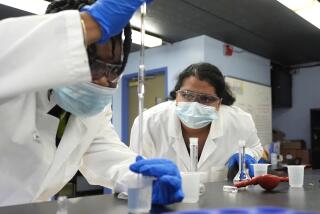Obama views destruction from Alabama tornadoes, calls it ‘heartbreaking’
As officials across the South continued the grim business of counting the dead and caring for the survivors, President Obama on Friday toured some of the areas in Alabama hit hardest by tornadoes.
Obama and his family arrived in the morning from Washington in a flight that took them over a long wound of destruction. After landing in Tuscaloosa, Obama traveled by motorcade through the city where neighborhoods were flattened and debris and rubble were constant companions.
“I’ve never seen devastation like this,” Obama said. “It’s heartbreaking.
Photo gallery: Tornadoes cut path of destruction
“We’re going to make sure you’re not forgotten,” the president pledged.
Under sunny skies that were in sharp contrast to the recent deadly storms, the president struck an optimistic note.
“What’s amazing is when something like this happens folks forget all their petty differences,” Obama said after talking to officials. “When we’re confronted by the awesome power of nature and reminded that all we have is each other.”
Minutes after Obama toured the ravaged neighborhood of Alberta, a group of volunteers signaled rescue workers and breathlessly told them that they had discovered several survivors in an apartment building nearby.
One of them was a young woman with cerebral palsy.
Paramedics raced to the scene and climbed over debris to reach the building. Three of the four apartments in the building had been almost completely destroyed. But one of the second-story apartments was intact.
Inside was a family — two parents and a teenage girl. The girl walks with crutches, and her mother didn’t think she would be able to get down the stairs. The mother, Millie, who would not give her last name, said they stayed in the house because they didn’t know where else to go.
They were helped out of the apartment, and up onto the street, down which Obama’s motorcade had raced only minutes before. The volunteers who discovered them, from Harvest Church, offered them chairs and cellphones to call family members. The young woman, whose name is Letisha, sat down and hungrily ate two hot dogs.
Away from the rescue, Obama continued his tour, visiting the Holt Elementary School outside the city limits. In the school auditorium, where clothes and supplies were lined up on the floor, Obama talked with Principal Debbie Crawford, some survivors and some aid workers. Crawford said she and a school nurse had been there for 48 hours.
“Thank you for helping, and I’m glad you’re OK,” Obama said.
The visit by the Obamas was designed to show the administration’s concern about the tragedy that has twisted the region and is approaching record proportions.
The politics of relief can be touchy, as the Bush administration learned in dealing with the aftermath of Hurricane Katrina and the Obama administration learned in dealing with the massive oil spill in the Gulf of Mexico. Press Secretary Jay Carney told reporters on Air Force One on Friday that Obama “wants to witness for himself the terrible devastation from these storms.”
The extent of damage was wide. Officials estimate that more than a million people remain without electricity. According to the Tennessee Valley Authority, 612,000 homes and businesses were without electricity. More than 120 power poles or steel support structures were damaged, resulting in about 70 large transmission lines being out of service, including a large portion of the 500-kilovolt and 161-kilovolt lines serving North Alabama and Mississippi.
In a radio interview on Friday, Tuscaloosa Mayor Walt Maddox said he had originally told federal emergency officials his city was a disaster. By Friday morning, he said he was ready to upgrade the description.
“I would classify it as a nightmare,” he said.
The death toll in his city stood at 42, a significant bloc of the more than 210 deaths reported in the state. The toll across the region stands at more than 300, and those numbers are expected to grow as search efforts turn to recovery. There were 33 dead in Mississippi, 34 in Tennessee, 15 in Georgia, five in Virginia and one in Kentucky.
The death toll is the greatest from an outbreak of U.S. tornadoes since April 1974, when 315 people were killed by a storm that swept across 13 Southern and Midwestern states, according to the National Weather Service. The National Oceanic and Atmospheric Administration’s revised preliminary estimates are 211 tornadoes on Wednesday and 835 so far this year.
In Tuscaloosa’s Rosedale Court, a housing project for low-income residents, dogs trained to sniff for bodies combed through the rubble. One dog, Ryka, gingerly walked over mangled metal, piles of bricks and splintered wood. She passed an overturned baby carriage, a set of bunk beds, and a Valentine’s Day basket that still held two milk-chocolate roses.
At a pile of debris near the back of one apartment, Ryka stopped and barked sharply, eight times.
A crew of seven search-and-rescue workers descended with steel pickaxes. They wrenched away window frames, pipes and pieces of roofing to uncover what was underneath. But no bodies were seen.
“I don’t smell death yet,” said Tuscaloosa Fire Capt. Quentin Brown, who was overseeing the recovery mission. “And I hope I don’t.”
Resources were stretched thin across the city, Maddox said. In Tuscaloosa alone, about 900 were injured in the storms and thousands were made homeless. But Maddox also said he was heartened by the way the town has come together.
“I saw whites, blacks, young, old working together yesterday on a house to save this little girl,” he said.
In Birmingham, where damage also was severe, weather forecasters began the day announcing that sunny skies would prevail over the weekend.
Radio and news broadcasts issued appeals for all kinds of basic supplies, and insurance advertisements asked people to begin assessing damage and submitting claims.
On the streets, National Guard troops rolled into neighborhoods where homes had turned into little more than sticks and debris.
Tennessee’s emergency management agency and the Alabama Emergency Management Agency recommended that persons traveling south from Tennessee into Alabama fill their vehicles with gasoline because power shortages have shuttered some service stations.
Shelter is needed for thousands, and water, food and clothing are becoming issues. Tuscaloosa officials urged residents to boil drinking water.
Back at that city’s Rosedale Court, James Dickson Jr. held a hammer in one hand, but he wasn’t sure how to proceed.
He had come to salvage some of his girlfriend’s possessions — “anything that was precious to her” — from the apartment at Rosedale Court she called home. Dickson was with her Wednesday when the tornado blew through.
But while recovery teams worked to find bodies in the rubble, survivors like Dickson were told to stay out.
Dickson has stayed at his mother’s house since the tornado. He has been helping his nephew try to find out what happened to his year-old son, who disappeared in the tornado.
He’s been trying not to think about the future.
It’s going to be “starting from nothing,” he said.
“And the hardest part,” he said, “is starting.”
Photo gallery: Tornadoes cut path of destruction
Linthicum reported from Tuscaloosa and Muskal from Los Angeles. Staff writers Richard Simon in Washington and Esmeralda Bermudez in Birmingham, Ala., contributed to this article.
More to Read
Start your day right
Sign up for Essential California for news, features and recommendations from the L.A. Times and beyond in your inbox six days a week.
You may occasionally receive promotional content from the Los Angeles Times.








